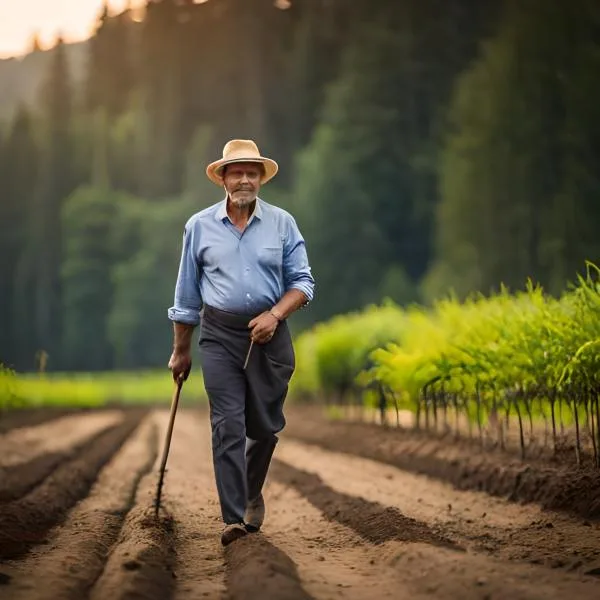Table of Contents
What is subsistence farming ?
In the ever-evolving landscape of modern agriculture, the term “subsistence farming” harks back to a traditional and fundamental approach to food production. Subsistence farming, also known as sustenance farming, is a method where farmers primarily cultivate crops and rear livestock to meet the basic needs of their own households, rather than for commercial purposes. In this article, we delve into the intricacies of subsistence farming, its significance in today’s world, and how it fits into the broader agricultural spectrum.
Understanding Subsistence Farming
Historical Roots
Subsistence farming has deep historical roots, dating back thousands of years to the dawn of agriculture. In the pre-industrial era, it was the prevailing method of food production worldwide. Communities relied on subsistence farming to ensure a stable food supply for their families. This method was characterized by small-scale cultivation of diverse crops, including staples like grains, vegetables, and fruits, as well as the rearing of animals for meat, milk, and other products.
OTHER NAMES OF subsistence farming
subsistence agriculture
subsistence crops
substantial farming
sustenance farming
Advantages and Disadvantages of Subsistence Agriculture
Advantages of Subsistence Agriculture
Importance of subsistence farming
Subsistence farming plays a pivotal role in fostering food security, especially in areas with unreliable access to markets or in times of crisis. By growing a diverse range of crops and raising livestock, subsistence farmers reduce their dependence on external food sources, ensuring a consistent supply of essential nutrients. This self-reliance becomes particularly critical during natural disasters or economic downturns when the flow of goods and services may be disrupted.
- Food Security :One of the most significant advantages of subsistence farming is its contribution to food security. By producing their own food, subsistence farmers are less vulnerable to external supply chain disruptions, ensuring a consistent source of nourishment for their families. This self-reliance is a powerful tool for combating hunger and malnutrition, especially in underserved regions.
- Economic Resilience : Subsistence farming empowers communities to be economically resilient. While not designed for profit, surplus produce can be sold or bartered, providing an additional income stream. This financial flexibility can be a lifeline during tough times, helping families weather economic uncertainties and invest in their future.
- Environmental Stewardship : Sustainable practices inherent to subsistence farming promote environmental stewardship. By avoiding the excessive use of synthetic chemicals and prioritizing biodiversity, subsistence farmers help protect ecosystems and reduce the environmental impact of agriculture. This approach aligns with the growing global awareness of the need for responsible land management and conservation.
Disadvantages of Subsistence Agriculture
On the other hand, more than disadvantages, subsistence agriculture entails a set of limitations that make it uncompetitive compared to other types of market agriculture. Some of these are:
- Its productivity is low compared to more modern forms of agriculture.
- It requires many man/hours of work for its tasks which are mainly manual.
- It is carried out mostly in contexts of poverty.
- It is difficult to increase your productivity without technological investment.
- It is done at the cost of deforestation of tropical forests.
How it is different from Hybrid Farming , Organic Farming
The Essence of Self-Sufficiency
At its core, subsistence farming embodies the spirit of self-sufficiency. Farmers work diligently to provide for their families’ basic nutritional needs, without surplus for trade or profit. This approach fosters a strong connection between the land, the farmer, and the food on the table. It’s a way of life deeply intertwined with nature and the seasons.
Types of Subsistence Farming
Subsistence Farming Examples
There are, in general, four types of subsistence agriculture. They have been used since the origin of agriculture and have changed relatively little over time.
- Shifting agriculture: In this type of farming, a patch of forest land is cleared by a combination of felling (chopping down) and burning, and crops are grown. After 2–3 years the fertility of the soil begins to decline, the land is abandoned and the farmer moves to clear a fresh piece of land elsewhere in the forest as the process continues. While the land is left fallow the forest regrows in the cleared area and soil fertility and biomass is restored. After a decade or more, the farmer may return to the first piece of land. This form of agriculture is sustainable at low population densities, but higher population loads require more frequent clearing which prevents soil fertility from recovering, opens up more of the forest canopy, and encourages scrub at the expense of large trees, eventually resulting in deforestation and soil erosion. Shifting cultivation is called dredd in India, ladang in Indonesia, milpa in Central America and Mexico and jhumming in North East India.
- Sedentary farming : While shifting agriculture’s slash-and-burn technique may describe the method for opening new land, commonly the farmers in question have in existence at the same time smaller fields, sometimes merely gardens, near the homestead there they practice intensive ”non-shifting” techniques. These farmers pair this with “slash and burn” techniques to clear additional land and (by the burning) provide fertilizer (ash). Such gardens near the homestead often regularly receive household refuse. The manure of any household chickens or goats are initially thrown into compost piles just to get them out of the way. However, such farmers often recognize the value of such compost and apply it regularly to their smaller fields. They also may irrigate part of such fields if they are near a source of water. In some areas of tropical Africa, at least, such smaller fields may be ones in which crops are grown on raised beds. Thus farmers practicing ”slash and burn” agriculture are often much more sophisticated agriculturalists than the term “slash and burn” subsistence farmers suggests.
- Nomadic herding: In this type of farming people migrate along with their animals from one place to another in search of fodder for their animals. Generally they rear cattle, sheep, goats, camels and/or yaks for milk, skin, meat and wool. This way of life is common in parts of central and western Asia, India, east and southwest Africa and northern Eurasia. Examples are the nomadic Bhotiyas and Gujjars of the Himalayas. They carry their belongings, such as tents, etc., on the backs of donkeys, horses, and camels. In mountainous regions, like Tibet and the Andes, yak and llama are reared. Reindeer are the livestock in arctic and sub-arctic areas. Sheep, goats, and camels are common animals, and cattle and horses are also important.
- Intensive subsistence farming : In intensive subsistence agriculture, the farmer cultivates a small plot of land using simple tools and more labour. Climate with large number of days with sunshine and fertile soils, permits growing of more than one crop annually on the same plot. Farmers use their small land holdings to produce enough for their local consumption, while remaining produce is used for exchange against other goods. It results in much more food being produced per acre compared to other subsistence patterns. In the most intensive situation, farmers may even create terraces along steep hillsides to cultivate rice paddies. Such fields are found in densely populated parts of Asia, such as in the Philippines. They may also intensify by using manure, artificial irrigation and animal waste as fertilizer. Intensive subsistence farming is prevalent in the thickly populated areas of the monsoon regions of south, southwest, and southeast Asia.
Shifting agriculture
Sedentary farming
Nomadic herding
Intensive subsistence farming
Techniques of Subsistence Farming
- Crop Diversity
One of the fundamental principles of subsistence farming is crop diversity. By cultivating a wide variety of crops, farmers can reduce the risk of crop failure due to pests, diseases, or adverse weather conditions. This approach not only guarantees a more reliable food source but also promotes soil health and biodiversity. Common subsistence crops include maize, rice, beans, and potatoes, chosen for their adaptability and nutritional value.
- Sustainable Farming Practices
Sustainability is at the heart of subsistence farming. Unlike industrial agriculture, which often relies heavily on chemical fertilizers and pesticides, subsistence farmers employ eco-friendly techniques. Crop rotation, composting, and the use of organic fertilizers are just a few methods that help maintain soil fertility and minimize environmental impact. These practices contribute to healthier ecosystems and reduce the carbon footprint associated with food production.
- Livestock Integration
In many subsistence farming systems, livestock are an integral component. Chickens, goats, cows, and other animals provide not only food but also valuable resources like milk, eggs, and wool. The integration of livestock into subsistence farming maximizes resource utilization and waste reduction. Additionally, it enhances soil fertility through the use of animal manure as a natural fertilizer.
Subsistence Farming in Poverty Alleviation
Subsistence agriculture can be used as a poverty alleviation strategy, specifically as a safety net for food-price shocks and for food security. Poor countries are limited in fiscal and institutional resources that would allow them to contain rises in domestic prices as well as to manage social assistance programs, which is often because they are using policy tools that are intended for middle- and high-income countries. Low-income countries tend to have populations in which 80% of poor are in rural areas and more than 90% of rural households have access to land, yet a majority of these rural poor have insufficient access to food. Subsistence agriculture can be used in low-income countries as a part of policy responses to a food crisis in the short and medium term, and provide a safety net for the poor in these countries.
Agriculture is more successful over non-agricultural jobs in combating poverty in countries that have a larger population of people without education or that are unskilled. However, there are levels of poverty to be aware of to target agriculture towards the right audience. Agriculture is better at reducing poverty in those that have an income of $1 per day than those that have an income of $2 per day in Africa. People who make less income are more likely to be poorly educated and have fewer opportunities; therefore, they work more labor-intensive jobs, such as agriculture. People who make $2 have more opportunities to work in less labor-intensive jobs in non-agricultural fields.
The Future of Subsistence Farming in the US
Is Subsistence Farming Still a Viable Option?
The Challenges of Growing Food in a Changing Climate
Challenges and Opportunities
Facing Modernization
While subsistence farming has its merits, it’s not without challenges. The encroachment of modernization, urbanization, and industrial agriculture poses a threat to this traditional way of life. As rural areas develop and populations grow, subsistence farmers face pressure to adapt or transition to more commercial forms of agriculture.
Empowering Rural Communities
Nonetheless, there are opportunities to empower subsistence farmers and promote their well-being. Initiatives aimed at improving access to education, technology, and markets can help these communities thrive. Supporting sustainable farming practices and facilitating value addition can enhance their economic prospects while preserving their cultural heritage.
The Future of Subsistence Farming in a Globalized World
Contemporary Relevance
A Global Perspective
In the 21st century, subsistence farming still plays a significant role, particularly in developing nations. While modern agricultural techniques and large-scale farming have become dominant, subsistence farming continues to be the primary source of food for millions of people worldwide. It provides a lifeline for many communities, ensuring their survival in the face of economic and environmental challenges.
Sustainable Practices
One of the notable aspects of subsistence farming is its inherent sustainability. By focusing on small-scale, diversified farming, it reduces the reliance on chemical inputs and promotes environmentally friendly practices. This can help mitigate some of the negative impacts associated with industrial agriculture, such as soil degradation and excessive resource consumption.
The Impact of Subsistence Farming on the Environment
Subsistence agriculture is done all over the world. Many communities experiencing poverty can find alleviation utilizing the methods of subsistence agriculture.
Conclusion
In conclusion, subsistence farming remains a resilient and time-honored practice in the realm of agriculture. While it may not dominate the modern agricultural landscape, its significance cannot be overstated. It ensures food security for countless families, promotes sustainability, and maintains a connection to our agricultural heritage. As we look to the future, it is essential to recognize the value of subsistence farming and work towards its preservation and enhancement.
Is subsistence farming only practiced in developing countries?

No, subsistence farming exists in various forms across the globe, including developed nations, where some families grow food for personal use.
Can subsistence farming be profitable?

While the primary goal of subsistence farming is self-sufficiency, some farmers may sell surplus produce locally to generate income.
What are the main crops grown in subsistence farming?

The choice of crops varies by region but often includes staple grains like rice, wheat, maize, and root vegetables.
How does subsistence farming contribute to food security?
By providing families with a reliable source of food, subsistence farming helps reduce reliance on external food sources and combats hunger.
What role can technology play in improving subsistence farming practices?

Technology can help subsistence farmers access valuable information, tools, and resources to enhance productivity and adapt to changing conditions.
Q: How does subsistence farming differ from commercial agriculture?
Subsistence farming is driven by the need for self-sufficiency and meeting basic needs, whereas commercial agriculture focuses on profit generation and market distribution.
What are the main types of subsistence farming?
Traditional subsistence farming, intensive subsistence farming, and slash-and-burn farming are the primary types of subsistence farming.
Why is subsistence farming important today?
Subsistence farming contributes to food security, preserves traditional knowledge, and promotes environmental sustainability, making it relevant in modern society.
What challenges do subsistence farmers face?
Subsistence farmers encounter challenges such as limited resources, vulnerability to climate change, and economic dependence on agriculture.
Are there sustainable practices in subsistence farming?
Yes, subsistence farming often incorporates sustainable practices like crop rotation and organic farming to reduce environmental impact.






Some truly interesting details you have written.Helped me a lot, just what I was looking for : D.